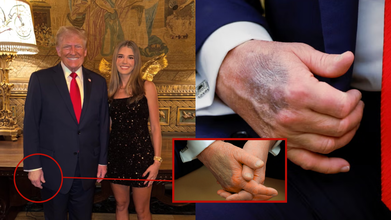- Health Conditions A-Z
- Health & Wellness
- Nutrition
- Fitness
- Health News
- Ayurveda
- Videos
- Medicine A-Z
- Parenting
- Web Stories
More Than Just Shrinking The Tumour: Expert Tells How Neoadjuvant Therapy Changes The Game In Breast Cancer Treatment

Credits: Canva
Breast cancer has a strange way of being both familiar and frightening. Almost everyone knows someone who has battled it, and yet the details of treatment often sound like an alien language. According to the World Health Organisation, breast cancer is the most common cancer among women worldwide, with 2.3 million new cases in 2022 alone. Among these, about 15 to 20 per cent are HER2-positive, the type that is fast-moving, aggressive, and hard to ignore.
Increasingly, the doctors are turning to a strategy that feels a bit like hitting “pause” before the main act—neoadjuvant therapy.
What Makes HER2-Positive Breast Cancer Tricky
HER2 (human epidermal growth factor receptor 2) is a protein that helps cells grow. In HER2-positive breast cancer, the cells get an overdose of this protein. As a result, the cancer multiplies faster than usual and is often linked to poorer outcomes.
“HER2-positive breast cancer is an aggressive type,” explains Dr Mandeep Singh Malhotra, co-founder, Art Of Healing Cancer. “It is very important to give the right information to patients and their families for better outcomes. With the right treatment sequence, it is possible to offer better treatment to patients.”
What Is Neoadjuvant Therapy?
Neoadjuvant therapy (NT) is like a warm-up session but for cancer treatment. Instead of rushing into surgery to remove the tumour, doctors first administer chemotherapy and targeted drugs. The idea is to shrink the tumour, make surgery easier, and gather valuable intel on how the cancer responds.
“Nowadays, when we talk about HER2-positive breast cancer, we talk about targeted therapy and dual targeted therapy involving both trastuzumab and pertuzumab,” says Dr Malhotra. Both are monoclonal antibodies, meaning they are lab-made molecules designed to stick to specific parts of cancer cells. Together with chemotherapy, they not only shrink tumours but also improve surgical outcomes.
Why Doctors Like It
One of the superpowers of neoadjuvant therapy is its ability to act as a kind of crystal ball. By giving treatment before surgery, doctors can tell which patients are “responders” and which are not.
“As Dr Malhotra puts it, “Even at early stages, if we give NT and then operate, we are able to prognosticate. Responders have a better prognosis. Non-responders have poorer prognosis and a higher chance of the cancer coming back.”
This ability to sort patients into risk categories allows doctors to tailor follow-up care more precisely. For example, non-responders may be put on more aggressive treatments, offered newer diagnostic tests like liquid biopsy, or monitored more closely.
The Big Advantage Over Surgery-First
Surgery-first and neoadjuvant-first have similar survival data, but the latter provides an extra layer of information.
“If we do upfront surgery in these patients, we lose the chance of prognostication,” says Dr Malhotra. “Secondly, even if we do the upfront surgery, we will still have to give chemo with targeted therapy after surgery. So the treatment does not change; the sequence changes. And with neoadjuvant therapy, we get the added benefit of knowing who is high risk and who is low risk.”
In other words, neoadjuvant therapy is not just about shrinking tumours; it is about outsmarting them.
What Patients Need to Keep in Mind
For patients, all of this can feel overwhelming. Surgery often seems like the most direct way to “get rid” of cancer, so the idea of delaying it can cause anxiety. But Dr Malhotra reassures patients that this approach is carefully designed.
“Even in very early-stage breast cancer, with a less than 1 cm tumour, I will not go for surgery first,” he says. “I will first give targeted chemotherapy. The reason is I see a lot of patients who have already had surgery and then are given the option of dual therapy. They are confused and afraid that the cancer will come back if they cannot afford either trastuzumab or pertuzumab.”
Interestingly, cost can also play a role. If patients achieve a complete response, meaning no invasive cancer remains after neoadjuvant therapy, sometimes treatment can be stopped earlier, sparing both physical and financial strain. “We lose this opportunity if surgery is opted for first,” Dr Malhotra adds.
The Future of HER2-Positive Breast Cancer Treatment
The shift towards neoadjuvant therapy represents a significant change in how doctors approach HER2-positive breast cancer. Instead of rushing in with surgery, the modern strategy is more like a chess game, carefully setting up each move to give patients the best possible outcome.
By combining chemotherapy with targeted drugs like trastuzumab and pertuzumab before surgery, doctors can shrink tumours, assess risk, personalise treatment, and often improve long-term survival.
Breast cancer treatment has always been a mix of science, strategy, and courage. Neoadjuvant therapy, especially in HER2-positive cases, is proving to be more than just a pre-surgery step. It is a game-changer, giving both patients and doctors a crucial edge in the fight.
As Dr Malhotra puts it, “Neoadjuvant therapy is not an inferior modality. With current data, we feel it is a superior one.”
Kai Trump’s New Instagram Post Sparks Questions About Donald Trump’s Health And His Mysterious Hand Bruise

Credits: Instagram and Reuters
The US President Donald Trump's health has been a heated topic of debate ever since he has returned to the White House. The most speculated topic on his health comes from the dark bruise on his right hand. Now, a series of images, which is posted by his granddaughter has now revealed how long the President has had the discoloration on his hand.
These photos have now sparked a new set of questions on Trump's health, especially after Trump has be declared fit during his recent medical checkup.
Also Read: What Does Trump's Latest Health Checkup Reveal About Him?
What Did Kai Trump's Photo Reveal About Trump's Health?
His 18-year-old eldest granddaughter took to Instagram on Wednesday and posted a series of pictures to commemorate the anniversary of her YouTube journey. She wrote: "One year ago, I started my YouTube channel not knowing what to expect...and it is turned into something so special."
However, in one of the images, Kai is seen with Trump and the president had a thick layer of makeup on his hand that would cover the bruise. The image was taken on the day of the results at the watch party hosted by Trump at Mar-a-Lago. This proves that the President had this bruise that he covered with makeup much before he even took over the office.
This discovery made people believe that the White House is deliberately trying to hide the president's health issues for months, especially under the guise of his semi-annual health check that declared him fit.
When Was The First Time Trump's Bruise Was Noticed?
The bruise first came under public's eye soon after Trump was elected and he himself said in a TIME Magazine interview in December 2024, that this has happened due to frequently shaking hands with thousands of people.
Seconding the same, in 2025, the White House also used the same explanation, where his doctor Dr Sean Barbabella said that these bruises were "minor soft tissue irritation". The doctor also said that his has happened due to frequent handshaking by him and his use of aspirin as part of his normal heart health routine. The side effect of this, with his hand bruising like this was said to be a 'benign and well known" side effect.
In a memo published by White House, his physician noted: "consistent with minor soft tissue irritation from frequent handshaking and the use of aspirin, which is taken as part of a standard cardiovascular prevention regimen".
The medical report also noted that Trump's swollen ankles were caused by chronic venous insufficiency. This is a condition where veins find it difficult to send blood back to heart. The White House Press Secretary Karoline Leavitt told the media that Trump was still "in exceptional health", while backing the physician's comment on his health.
Recent Update On Trump's Health
Previously, Health And Me reported on an exclusive published on tabloid Radar, on October 16, that claimed that Trump is 'riddled with arthritis', and that he may need a double hip replacement surgery.
Read: Is US President Donald Trump Getting A Double Hip Replacement Surgery?
The tabloid’s report paints a sensational picture of severe arthritis and an alleged plan for double hip replacement, citing unnamed “sources” and hinting at possible cognitive issues. The story has since been picked up by several aggregator sites, spreading widely despite the absence of verified evidence. However, the publication provided no medical records, surgeon's statements, or official documents to support the claim.
However, as per the physical examination by the Walter Reed National Medical Center, President had no orthopedic surgery listed in his history.
Got Covid And Feeling Worse? These 3 Symptoms Could Be A Major Warning

Credits: Canva
Health officials are urging people to seek immediate medical help if they notice three particular symptoms appearing alongside Covid, as these could signal a more serious infection.
According to the latest data from the UK Health Security Agency (UKHSA), Covid cases have dipped slightly but remain present at “low levels” across the country. Hospital admissions have also fallen modestly, with weekly test positivity dropping to 10.3 percent from 11.9 percent the week before.
Despite the decline, people aged 85 and older continue to face the greatest risk of being hospitalised with the virus. Experts stress that identifying certain warning symptoms early can be key to preventing complications and ensuring timely treatment.
3 Covid Symptoms That Are Major Warning
People are being urged to seek urgent medical advice if they or their child develop three specific symptoms while infected with Covid, as it may point to a more serious illness.
Health experts recommend contacting a GP or calling for medical assistance if symptoms such as a rash, loss of appetite, or unusual weakness appear. Immediate help is also advised if a high temperature of 38°C or above lasts for five days or fails to reduce with paracetamol.
Medical attention is further encouraged if symptoms worsen, show no improvement, or if you are unsure how to manage them. For infants, extra caution is necessary as any baby under three months old with a temperature of 38°C or higher, or a child aged three to six months with a temperature above 39°C, should be assessed by a healthcare professional.
Covid Booster Shots: Who Can Get Them This Autumn
The eligibility rules for Covid booster vaccines have been updated for the current autumn rollout. While earlier boosters were offered to people aged 65 and above and those with certain long-term conditions, this year’s criteria have been made more specific.
Those eligible for the latest booster include:
- Adults aged 75 and over, including anyone who will turn 75 by January 31, 2026
- Individuals aged six months to 74 years with a weakened immune system due to illness or medical treatment
- Residents of care homes for older adults
- Health officials continue to encourage eligible groups to stay up to date with vaccinations, especially heading into the winter season, when respiratory infections tend to rise.
COVID-19 Variant Stratus: What You Should Know
A new COVID-19 strain known as Stratus, officially labeled XFG, has begun to circulate globally. First identified in Southeast Asia in January 2025, the variant quickly spread across 38 countries by mid-year. The World Health Organization (WHO) has classified Stratus as a “variant under monitoring,” meaning it is being closely studied to understand its transmission rate, symptom pattern, and potential health impact.
Frankenstein Variant: Common Symptoms of Stratus
For most people, especially those who are vaccinated or boosted, Stratus infections appear to be mild to moderate. Still, recognising its symptoms early remains important.
The most common signs include:
- Persistent dry cough
- Tiredness or fatigue
- Fever
- Other possible symptoms:
- Shortness of breath or chest tightness
- Sore or scratchy throat
- Headache and body aches
- Upset stomach, nausea, or loss of appetite
- Loss of taste or smell (now less frequent)
- Brain fog or difficulty concentrating
Atorvastatin Recall 2025: Safe Alternatives For Keeping Cholesterol In Check

Credits: CANVA
Atorvastatin Recall 2025: Statins have long been the first-line treatment for high cholesterol, but the Food and Drug Administration (FDA) has confirmed a nationwide recall of over 140,000 bottles of a cholesterol-lowering medication. Officials flagged that some pills may not dissolve properly after ingestion, potentially reducing effectiveness for patients who rely on them daily.
The recall affects Atorvastatin Calcium, the generic version of Lipitor, which is taken by roughly 39 million Americans, most of them adults over 40, according to Dr. Tamanna Singh of the Cleveland Clinic. Federal records show that the recalled batches were manufactured by Alkem Laboratories and distributed by Ascend Laboratories in New Jersey. The FDA’s September 19 enforcement report found that several batches failed quality tests designed to ensure proper dissolution of the pills.
If the pills dissolve inconsistently or more slowly than intended, the medication may not deliver the expected cholesterol-lowering effect. The FDA classified the recall as a Class II action, indicating moderate concern. While temporary or reversible side effects could occur, the likelihood of serious harm is low.
Atorvastatin Recall: Which Atorvastatin Tablets Are Affected
The recall covers multiple strengths and bottle sizes of Atorvastatin Calcium Tablets, which are among the most commonly prescribed statins globally. Affected formulations include:
- 10 mg – 90, 500, and 1,000 tablets per bottle
- 20 mg – 90, 500, and 1,000 tablets per bottle
- 40 mg – 90, 500, and 1,000 tablets per bottle
- 80 mg – 90 and 500 tablets per bottle
Cholesterol Medication Recalled: Safe Alternatives to Atorvastatin
If you are affected by the recall, there are several alternatives to help manage cholesterol levels effectively:
1. Ezetimibe (Zetia)
Ezetimibe is often recommended when a statin alone doesn’t sufficiently lower cholesterol. It may be used if you are on the maximum statin dose but your cholesterol remains high, or alongside statins such as atorvastatin or simvastatin for conditions like homozygous familial hypercholesterolemia.
Ezetimibe works by blocking cholesterol absorption in the small intestine, causing the body to use up more cholesterol from the blood. It is one of the few non-statin medications that can further reduce LDL cholesterol, either alone or combined with statins or other alternatives.
2. Fibrates (e.g., gemfibrozil, fenofibrate)
Fibrates mainly target high triglyceride levels, a type of fat in the blood linked to heart disease and pancreatitis, and can also mildly lower LDL cholesterol. They can be taken alone, with ezetimibe, or with a statin. However, combining gemfibrozil with a statin may increase side effects, so caution is advised.
3. Bile Acid Sequestrants (e.g., cholestyramine, colestipol, colesevelam)
Bile acid sequestrants lower cholesterol by binding bile acids in the intestine, preventing their reabsorption. The liver then uses more cholesterol from the blood to produce new bile acids, reducing LDL cholesterol.
Potential drawbacks include:
- Multiple pills per day may be needed
- Possible interactions with other medications or vitamins, which can reduce effectiveness
- May increase triglyceride levels
- Can cause constipation or stomach upset
© 2024 Bennett, Coleman & Company Limited

